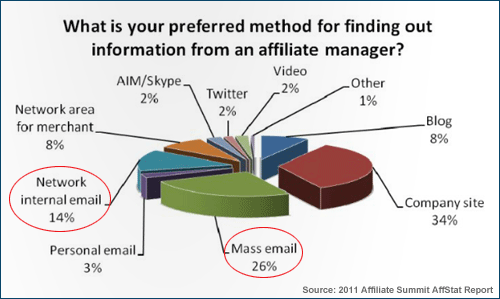It has been some time since I’ve last addressed the subject of email newsletter open rates, and today as I was analyzing the data of two different Commission Junction-based affiliate programs, I couldn’t help but notice the drop.
2009
In this post I wrote that the registered open rate was 17.65%.
2012
In a 3-year-old affiliate program (8.676%):
![]()
In a 1-month-old affiliate program (11.872%):
![]()
Rounding the numbers up, between 17.7% in 2009 and 8.7% in 2012 it is apparent that we’re registering a tremendous 9% drop. This is a worrying statistic.
However, according to the findings of AffStat 2011 Report the majority of affiliates (40%-43%) do prefer to be contacted via email:

Yet, based on the above-quoted disheartening open rates statistic, it seems that, wherever possible, affiliate managers should give preference to personal emails. The same AffStat Report also revealed the following:
![]()
At the very least, affiliate program managers should (a) segment their affiliate base, (b) micro-categorize affiliates in each segment based on needs, professional readiness, activity level, and other factors, (c) creating group-specific customized versions of the newsletter — all to maximize each circular’s relevance for individual affiliates.
I saw this in my feed as i was writing an email to go out to publishers.
I have similar numbers as of late (9-10% openrates). I’ve even sent them as Plain Text just to see if it garnered a better response. This wasn’t the case.
I’ve also looked at the lifespan of a typical affiliate. In 2009 there was an affilite survey run by Affiliate Window that a majority of publishers are less than 3 years old (24% being a 12-18 months). A lot has changed since 2009, I am wondering if there has been a similar survey released recently. Awin did not do it again this year
The above-quoted AffStat report has that “lifespan” data (3rd pie-chard in the report; the one on page 3). I think, I’ve also seen something like this in Econsultancy’s Affiliate Census reports.
Correct, it was the one ran by E-consultancy in 2009. The most recent was done in 2011 with CJ and A4U.
Awin released theirs to all merchants and it had some decent information.
Can you analyze data that distinguishes “active” affiliates from inactive? I’m enrolled in hundreds of affiliate programs (down from thousands in past years), but I have only about a dozen relationships which are active (e.g. I have live links posted on one of my web sites).
Among those advertisers, I pay attention to emails — but some send useless emails every week which I ignore.
I’m just starting a major update cycle for one of my sites, and I’m definitely paying more attention to ALL emails from affiliate managers. For example, I got an email today from CJ announcing that a marginal merchant is dropping its rate from 5% to 3%, and I took the time to email the affiliate manager that I was about to explore that merchant for addition to my site, but this email persuaded me not to waste my time.
No, Mark, unfortunately, I cannot see any breakdown of “active” vs inactive affiliates there. I see it exactly the same way you can see it on the screenshots in my post (Delivered, Failed, and Opened). With inactive affiliates, though, it is especially for me to get them to open these newsletter; because I’m offering them customized incentives to activate.
I have seen the same results in my programs. Personal emails are more time consuming but the most effective. Even when I do micro categorizing, I don’t see the number go up siginificantly. As a result, I do less public newsletters and more one on one. Now I will say these stats do not apply to my coupon sites.
Thank you for sharing your experience, Stephanie. Yes, nothing can ever beat a 100% personal email.